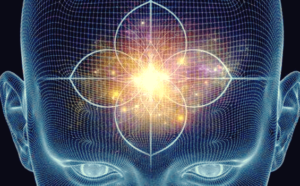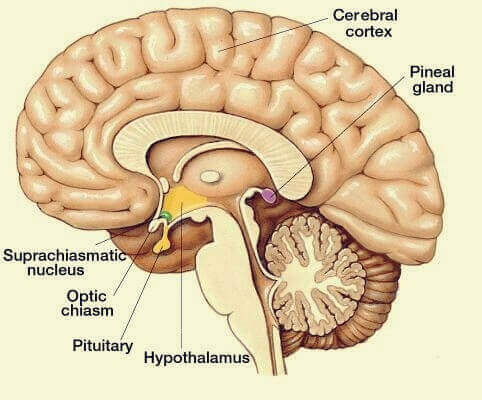The Pituitary and Pineal Glands: Functions and Characteristics


Written and verified by the psychologist Sergio De Dios González
The pituitary and pineal glands regulate many of your hormonal processes. They’re the little center of power in your brain that Descartes defined as the seat of the soul. This sophisticated chemical laboratory mediates processes as basic as your rest and relaxation, your aging, and the balance of your thyroid.
When we look for information about these tiny glands, it’s common to find multiple references from the spiritual world. This is hardly surprising. In fact, for many, this ‘third eye’ connects with your most magical and intuitive side. The imprint of these structures in our culture is due to the fact that they’re connected to the cycles of light and darkness.
As a human being, you govern your biological rhythms in tune with nature. Sunlight sets up a channel that stimulates the little nuclei of your brain. The pituitary and pineal glands are like conductors of an orchestra. They’re the ones that guide your growth, sexual maturity, temperature, and even regulate your emotions.
Any small imbalance has a direct impact on your well-being.
They’re called the master glands or even the third eye. In fact, the pituitary and pineal glands configure the factory that regulates your hormones to guarantee your balance and well-being.

The functions of the pituitary and pineal glands
Most of the information we know about the pituitary and pineal glands comes from pathological neurology studies carried out on these structures. For example, authors and experts on the subject such as doctors J. Anderson, N. Antoun, and K. Chatterjee point out in a research work that part of the people who suffer from hormonal problems have an alteration in these structures as their origin.
These glands are extremely small (just under 8 mm) and they receive a large flow of blood. This means that they’re extremely important. At the same time, we can’t neglect another detail: they’re extremely sensitive to your lifestyle.
Let’s take a look at the function of each of them.
Pituitary gland or hypophysis
One fascinating aspect of this gland is the way it connects with your environment. In fact, based on all the information it receives from your senses and your thalamus, it releases a series of hormones. These allow you to adjust and react more successfully to external demands.
- The pituitary gland or hypophysis facilitates social connection. Furthermore, it helps you react to danger.
- It favors the release of oxytocin to strengthen your bonds with your partners, children, etc.
- It stimulates the release of adrenal hormones so that you can better withstand stress.
- The pituitary gland also works in conjunction with the hypothalamus.
- The hypothalamus, related to your emotions and your memory, in turn, is influenced by the pituitary gland.
- In fact, the union between the pituitary gland and the hypothalamus controls the process of changing what you think and perceive into an emotional state.
It’s also important to highlight the involvement of this gland with certain biological processes. It
- Regulates metabolism.
- Stimulates the stimulating hormone (FSH) and luteinizing hormone (LH). These release estrogen, testosterone, and progesterone.
- Stimulates prolactin, necessary for milk production.
- Mediates the production of melanocytes to take care of your skin pigmentation.
- Stimulates growth hormones and human development.
As we mentioned earlier, the pituitary gland is extremely sensitive to your environment. Sheba University, Tel Hashomer (Israel) conducted a study in which they explained that there’s a relationship between ionizing radiation and the appearance of tumors in this structure.

The pineal gland: the regulator of cycles
The pituitary and pineal glands share a number of functions. However, the latter is the one that’s always aroused the greatest interest from a mystical and spiritual point of view. Perhaps it’s because of its tree shape, or its fragility, or because it needs darkness to function effectively.
Interestingly, once you reach adolescence, the activity of the pineal gland begins to decrease. So much so that it’s common to reach adulthood with a pineal gland that’s already beginning to show signs of calcification. Its sensitivity to your environment, food, environmental toxins, and your lifestyle sometimes reduces its proper functioning.
Let’s take a look at what processes are regulated by the pineal gland. It:
- Regulates your circadian rhythm and induces sleep.
- Secretes melatonin in darkness. The University of Hokkaido (Japan) conducted a study that explained that any alteration in this structure will directly affect your nightly rest.
- Is key to sexual maturation.
- Any alteration in this structure can even mediate the appearance of seasonal affective disorder and depression.
How can you take better care of your pituitary and pineal glands?
Currently, interest in the pituitary and pineal glands is increasing. Beyond the mystical and spiritual field, we find more and more works on the subject aimed at the general public. One example is the Journal of Pineal Research, which includes studies that are as fascinating as they’re practical.
These structures are a clear example of how your endocrine system also mediates your behavior and personality. In fact, the effects of diseases such as hypothyroidism or hyperthyroidism are well recognized. Nevertheless, these disorders don’t only affect your metabolism and weight. They also influence your moods and your rest.

For this reason, it can certainly be useful to learn how you can take better care of these structures. For example, you should:
- Maintain a diet as natural as possible, free of pesticides, dyes, and preservatives.
- Eat raw, organically grown foods. This reduces pineal gland calcification.
- Improve your supply of vitamins A, D, and the B complex, as well as minerals such as magnesium or manganese.
- Try and adjust to the cycles of nature. Indeed, if you always lived your life in daylight and rested when it’s dark these glands would appreciate it.
- Reduce your exposure to blue light from electronic devices.
Of the two glands, the most important is undoubtedly the pituitary gland or hypophysis. It’s the most relevant endocrine structure. That’s because it regulates almost all the processes in your body. Therefore, it’s well worth taking care of it. For this reason, you should try and adjust your lifestyle in a healthier way that’s more in line with the rhythms of the day and night.
All cited sources were thoroughly reviewed by our team to ensure their quality, reliability, currency, and validity. The bibliography of this article was considered reliable and of academic or scientific accuracy.
- Kandel, E.R.; Schwartz, J.H. & Jessell, T.M. (2001). Principios de neurociencia. Cuarta edición. McGraw-Hill Interamericana. Madrid.
- Frank H. Netter, Peter H. Forsham,Emilio Gelpi Monteys (1998). Sistema Endocrino y Enfermedades Metabólicas. España: Masson
This text is provided for informational purposes only and does not replace consultation with a professional. If in doubt, consult your specialist.








